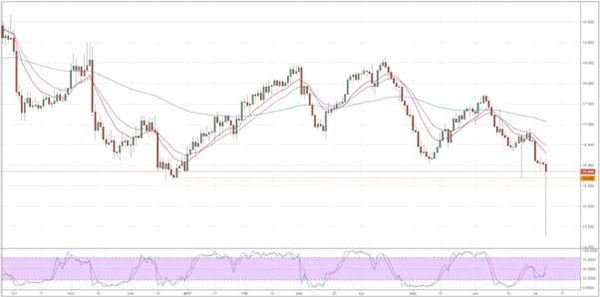Key Points:
- A flash crash has hit silver markets leaving many traders scratching their heads.
- Numerous explanations have been put forward, including the less reliable ones.
- Prices seem to have stabilised now.
Silver prices have been the subject of significant debate of the past few hours as a result of a flash crash that saw the metal plummet to the $14.27 handle before roaring higher within moments. Of course, this has brought out the usual speculations and accusations about exactly what was driving the movement so we have collected a few honourable mentions that might help to explain the crash.
Firstly, the classic ‘fat finger’ argument has been put forward by numerous analysts as a contributing factor to the tumble. To elaborate,a fat finger is when human input error generates a substantially erroneous trade – typically via an extra zero here or there. As entertaining as the notion is, such mistakes are typically safeguarded against by various fail safes. What’s more, a spike of this size in such a heavily followed market would almost certainly have been picked up prior to execution.

One slightly more plausible suggestion has been a sudden liquidity drain that sparked a bout of panic selling. Indeed, markets have been fairly thin over the 4th of July holiday period which could have compounded fears that silver was becoming illiquid in the wake of JP Morgan’s recent acquisitions. This being said, the extent to which JP Morgan has ‘rigged’ silver markets is constantly challenged and courts seem to be unable to agree on whether or not the institution is breaking antitrust legislation.
Stop loss orders have also been fingered as a cause for the sudden rout for all the usual reasons. Specifically, the hitting of numerous stop loss orders in rapid succession could have easily amplified the effects of a sell-off – even if they probably didn’t trigger the downtrend in the first place. Moreover, given that many traders may have been out of action due to the holiday’s in the US, it’s quite reasonable to expect more ‘set and forget’ trades to have been placed than is typical. This would have left the metal more exposed to this type of risk than we would usually expect.
Ultimately, there are many other potential explanations for what was hammering silver prices but we may never get to the bottom of it. These include, but are not limited to, algorithmic traders, glitches, stub quotes, and so on. Indeed, it was probably a mix of some, if not all, of the above. Nevertheless, it at least looks as though the metal has stabilised now and it could meander higher now that we are out of the woods. This should see the metal make a beeline for the $16 handle in the coming days, especially as political tensions from the G20 Summit begin to be felt.














